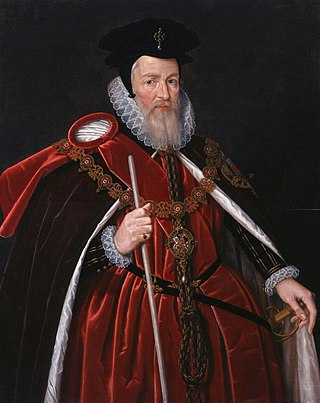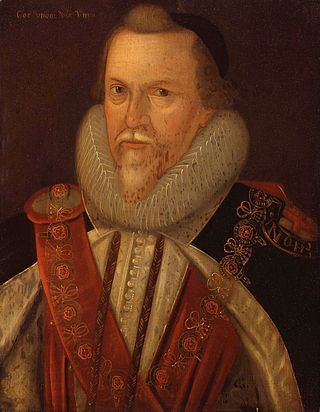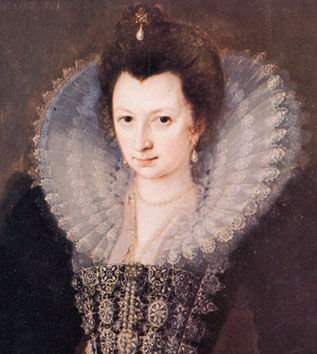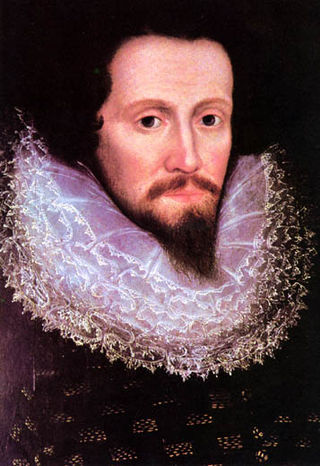Related Research Articles

Edward de Vere, 17th Earl of Oxford, was an English peer and courtier of the Elizabethan era. Oxford was heir to the second oldest earldom in the kingdom, a court favourite for a time, a sought-after patron of the arts, and noted by his contemporaries as a lyric poet and court playwright, but his volatile temperament precluded him from attaining any courtly or governmental responsibility and contributed to the dissipation of his estate.

William Cecil, 1st Baron Burghley was an English statesman, the chief adviser of Queen Elizabeth I for most of her reign, twice Secretary of State and Lord High Treasurer from 1572. In his description in the Encyclopædia Britannica Eleventh Edition, A.F. Pollard wrote, "From 1558 for forty years the biography of Cecil is almost indistinguishable from that of Elizabeth and from the history of England."

Robert Cecil, 1st Earl of Salisbury, was an English statesman noted for his direction of the government during the Union of the Crowns, as Tudor England gave way to Stuart rule (1603). Lord Salisbury served as the Secretary of State of England (1596–1612) and Lord High Treasurer (1608–1612), succeeding his father as Queen Elizabeth I's Lord Privy Seal and remaining in power during the first nine years of King James I's reign until his own death.

Henry Wriothesley, 3rd Earl of Southampton, was the only son of Henry Wriothesley, 2nd Earl of Southampton, and Mary Browne, daughter of Anthony Browne, 1st Viscount Montagu. Shakespeare's two narrative poems, Venus and Adonis and The Rape of Lucrece, were dedicated to Southampton, who is frequently identified as the Fair Youth of Shakespeare's Sonnets.

Thomas Cecil, 1st Earl of Exeter, KG, known as Lord Burghley from 1598 to 1605, was an English politician, courtier and soldier.

Roger Manners, 5th Earl of Rutland was the eldest surviving son of John Manners, 4th Earl of Rutland and his wife, Elizabeth nee Charleton. He travelled across Europe, took part in military campaigns led by the Earl of Essex, and was a participant of Essex's rebellion against Queen Elizabeth I. He was favoured by James I, and honoured by his contemporaries as a man of great intelligence and talent. He enjoyed the friendship of some of the most prominent writers and artists of the Elizabethan age and Jacobean age. In 1603 he led an Embassy to Denmark, homeland of James' Queen Anne of Denmark.

Theobalds House in the parish of Cheshunt in the English county of Hertfordshire, north of London, was a significant stately home and (later) royal palace of the 16th and early 17th centuries.
Cecil House refers to two historical mansions on The Strand, London, in the vicinity of the Savoy. The first was a 16th-century house on the north side, where the Strand Palace Hotel now stands. The second was built in the early 17th century on the south side nearly opposite, where Shell Mex House stands today.
John Manningham was an English lawyer and diarist, a contemporary source for Elizabethan era and Jacobean era life and the London dramatic world, including William Shakespeare.

Elizabeth Stanley, Countess of Derby, Lord of Mann, was an English noblewoman and courtier. She was the eldest daughter of the Elizabethan courtier and poet Edward de Vere, 17th Earl of Oxford.

Susan Herbert, Countess of Montgomery, was an English court office holder. She served as lady-in-waiting to the queen consort of England and Scotland, Anne of Denmark. She was the youngest daughter of Elizabethan courtier, and poet Edward de Vere, 17th Earl of Oxford.

Anthony Bacon (1558–1601) was a member of the powerful English Bacon family and was a spy during the Elizabethan era. He was Francis Bacon's elder brother.

Garden hermits or ornamental hermits were people encouraged to live alone in purpose-built hermitages, follies, grottoes, or rockeries on the estates of wealthy landowners, primarily during the 18th century. Such hermits would be encouraged to remain permanently on site, where they could be fed, cared for, and consulted for advice, or viewed for entertainment.
Costume and gold and silver plate belonging to Elizabeth I were recorded in several inventories, and other documents including rolls of New Year's Day gifts. Arthur Jefferies Collins published the Jewels and Plate of Queen Elizabeth I: The Inventory of 1574 from manuscripts in 1955. The published inventory describes jewels and silver-plate belonging to Elizabeth with detailed references to other source material. Two inventories of Elizabeth's costume and some of her jewellery were published by Janet Arnold in Queen Elizabeth's Wardrobe Unlocke'd.
The Harefield Entertainment included hospitality and performances for Elizabeth I of England in August 1602. Several copies of the performance script survive, probably written by John Davies, along with the original manuscript accounts of the Queen's host which seems to have been manipulated by literary forgery in the 19th-century to enhance their interest.
Marion Evelyn Colthorpe was a British historian and Elizabethan scholar.

Elizabeth Southwell (1584–1631) was an English courtier who lived in Florence.
Cordell Annesley was an English courtier.
The Entertainment of the Two Kings of Great Britain and Denmark or The Hours was written by Ben Jonson and performed at Theobalds House on 24 July 1606. John Harington of Kelston described another masque of Solomon and Sheba, performed one day at Theobalds after dinner. There is some doubt over Harington's account. In May 1607 another masque An Entertainment of the King James and Queen Anne at Theobalds was performed when the keys of the house were given to Anne of Denmark.
Tudor Royal Progresses were an important way to for the Tudor monarchs to consolidate their rule throughout England. Following his victory at the Battle of Bosworth in August 1485, the first Tudor monarch, Henry VII, ensured his coronation, called a parliament, married Elizabeth of York – all in London before embarking on his first Royal Progress in March 1486. The last Tudor Royal Progress took place in summer 1602, as Elizabeth I, the last Tudor monarch died in March 1603.
References
- ↑ Elizabeth Goldring, Faith Eales, Elizabeth Clarke, Jayne Elisabeth Archer, John Nichols's Progresses and Public Processions of Queen Elizabeth: 1579-1595, vol. 3 (Oxford, 2014), p. 529.
- ↑ Gabriel Heaton, 'Elizabethan Entertainments in Manuscript: The Harefield Festivities and the Dynamics of Exchange', in Jayne Elisabeth Archer, Elizabeth Goldring, Sarah Knight, Progresses, Pageants, and Entertainments of Queen Elizabeth (Oxford, 2007), p. 229: James Sutton, Materializing Space at an Early Modern Prodigy House: The Cecils at Theobalds (Aldershot, 2004), pp. 95-123.
- ↑ Stephen Alford, All His Spies: The Secret World of Robert Cecil (Allen Lane, 2024), p. 77.
- ↑ Elizabeth Zeman Kolkovich, The Elizabethan Country House Entertainment: Print Performance and Gender (Cambridge, 2016), p. 43 (modernised here).
- ↑ Alexander Dyce, The Dramatic and Poetical Works of Robert Greene and George Peele (London, 1861), p. 577.
- ↑ Stephen Alford, Burghley: William Cecil at the Court of Elizabeth I (Yale, 2011), p. 313: Gabriel Heaton, 'Elizabethan Entertainments in Manuscript: The Harefield Festivities and the Dynamics of Exchange', p. 229.
- ↑ Gabriel Heaton, 'Elizabethan Entertainments in Manuscript: The Harefield Festivities and the Dynamics of Exchange', p. 229: British Library, Egerton MS 2623.
- ↑ John Strype, Annals of the Reformation, vol. 4 (London, 1731), p. 77-8: (1824), pp. 108-9 The mock charter still exists and is owned by the Elizabethan Club at Yale University.
- ↑ Mock Charter, Elizabethan Club, Yale Orbis
- ↑ Marion Colthorpe, 'The Theobalds entertainment for Queen Elizabeth I in 1591, with a transcript of the Gardener's Speech', REED Newsletter, 12:1 (1987), p. 2.
- ↑ Martin Wiggins & Catherine Teresa Richardson, British Drama, 1533-1642: 1590-1597, vol. 5 (Oxford, 2013), pp. 74-5: HMC Salisbury Hatfield, vol. 14 (London, 1923), p. 321.
- ↑ Marion Colthorpe, 'The Theobalds entertainment for Queen Elizabeth I in 1591, with a transcript of the Gardener's Speech', REED Newsletter, 12:1 (1987), pp. 7-8 transcription of Cecil Papers 140/94: See also BL Egerton MS 2623.
- ↑ Jane Ashelford, Dress in the Age of Elizabeth (London, 1988), p. 100.
- ↑ Elizabeth Zeman Kolkovich, The Elizabethan Country House Entertainment: Print, Performance and Gender (Cambridge, 2016), p. 44.
- ↑ Martin Wiggins & Catherine Teresa Richardson, British Drama, 1533-1642: 1590-1597, vol. 5 (Oxford, 2013), p. 74.
- ↑ Alexander Dyce, The Dramatic and Poetical Works of Robert Greene and George Peele (London, 1861), p. 579.
- ↑ HMC Salisbury Hatfield, vol. 4 (London, 1892), p. 108: Mary Anne Everett Green, Calendar State Papers Domestic, 1591-1594 (London, 1867), p. 38.
- ↑ Annie Cameron, Warrender Papers, vol. 2 (Edinburgh: SHS, 1932), pp. 223-6: John Nichols, Progresses of Queen Elizabeth, vol. 3, p. 241.
- ↑ Martin Butler, The Stuart Court Masque and Political Culture (Cambridge, 2008), pp. 125-7: Clare McManus, 'When is woman not a woman?', Modern Philology, 105 (2008), pp. 437-74.